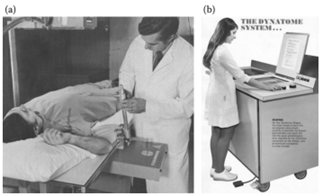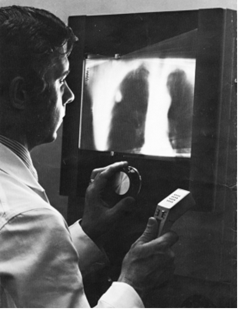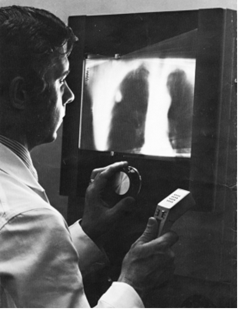1.2.2 Rapid Film Changer Tomosynthesis Systems
1.1.1.1 Dynatome system of Albert Richards
The first commercial film-based tomosynthesis system, the Dynatome by CFC Products, Inc., was developed in the 1970s and the 1980s by Albert Richards, MS (Physics), a professor of dentistry at the University of Michigan Dental School. Ten radiographic films were acquired at different angles along a linear tomographic sweep of the patient. A rapid film changer was employed to acquire these films at a rate of ≥2 films/s. A special film developed by Eastman Kodak specifically for the low-density exposures associated with this system was employed. A calibrator was utilized (Figure 1.5a) for determining the angle for each film and the films were trimmed and shaped based on the projection angles (Figure 1.5b).

Figure 1.5 calibrator (a) and film shaper (b) in dynatome dynamic tomography system.
The developed films were arranged on a custom high-intensity light box viewer (Figure 1.6) and moved with a dial in a precise relationship to each other, so information from any level common to all films could be registered. By moving the dial, the equivalent of about 100 contiguous slices could be viewed, each with a thickness of 2 mm. The total radiation dose to the patient was about equal to that of two or three plain films.

Figure 1.6 dynatome tomosynthesis viewer
Richards described the principles of dynamic tomography, his name for tomosynthesis, in a paper published in 1976 (Richards 1976). In that paper, he stated that he found moving the x-ray source in a circular path yielded “better results than can be achieved with linear movement.” Richards demonstrated the principle of “circular-movement” dynamic tomosynthesis by taking separate films of human cadaver skulls at eight locations along a circular path, each location separated by 45°, with manual orientation of each film cassette. For viewing, the developed films were superimposed on a bright viewbox; the long axis of each film was rotated 45° relative to the previous film, and 180° opposite film pairs (e.g., 0° and 180°, 45° and 225°) were shifted together along paths through their longitudinal axes. Richards stated that all that was needed to make circular movement dynamic tomography practical for live patient imaging was the construction of an apparatus that would provide rapid changing and proper orientation of the eight film cassettes. He also prophesized that a future application of dynamic tomography would be the examination of the beating heart, layer by layer, and this would be accomplished with EKG gating and very short exposures (Richards 1976).
1.2.2.2 Rapid film changer system of Miller
A rapid film changer tomosynthesis system similar to Richard’s Dynatome was developed by Miller et al., but was never commercialized (Miller et al. 1971). Unique to Miller et al.’s rapid film changer system was the production of hardcopy films by illuminating the projection radiographs in a photographic camera, with shifting of either the camera or the radiographs to produce a film showing an image of the desired focal plane
1.2.2 快速胶片交换的断层合成
1.2.2.1 Albert Richards的Dynatome系统
Dynatome,由CFC出品的第一个商业的基于胶片的断层合成系统,由密歇根大学的牙科教授 Albert Richards(物理学硕士),于1970至1980年代开发。沿患者以线性断层扫描的方式,获取十张不同角度的射线照相胶片。使用快速胶片更换器以≥2张/秒的速度获取这些胶片。使用了由柯达(Eastman Kodak)专门为此类低密度曝光的系而开发的胶卷。利用准直器(图1.5a)确定每个胶片的角度,并根据投影角度对胶片进行校正和剪裁(图1.5b)。

图1.5动态断层摄影系统Dynatome中的准直器(a)和胶片裁剪(b)。
显影的胶片被放置在定制的高强光观察器上(图1.6),并根据其相对关系,通过刻度盘精确地移动,因此胶片上所有层面的任何公用的信息,都可以被记录下来。通过移动刻度盘,可以看到相当于100个连续切片,每个切片的厚度为2毫米。对患者的总辐射剂量大约等于两到三个平片的辐射剂量。

图1.6 Dynatome断层合成观察器
Richards在1976年发表的一篇论文中描述了动态断层摄影的原理,他称之为断层合成(Richards 1976)。他在论文中指出,他发现沿圆形路径移动X射线源产生的“结果比线性移动所能达到的更好。” Richards通过沿圆形路径在八个位置拍摄人类尸体头骨的独立胶片来证明“圆周运动”动态断层合成的原理,每个位置之间的夹角为45°,每个胶片盒均手动定位。为了观看,将冲洗过的胶片叠加在明亮的观察器上,每个胶片的长轴相对于先前的胶片旋转45°,相互成180°的胶片对(例如0°和180°,45°和225°)沿着其纵轴一起移动。Richards指出,要使圆形运动动态层析成像技术适用于患者成像,所需要做的就是构造一台设备,该设备可以快速且正确的改变八个胶卷暗盒的位置和方向。他还预言,动态断层成像的未来应用将是逐层检查跳动的心脏,这将通过EKG门控和非常短的曝光来实现(Richards 1976)。
1.2.2.2 Miller的快速胶片交换系统
Miller等人开发了类似于Richard的Dynatome快速胶片转换断层合成系统,但从未商业化(Miller等人1971)。Miller等人的快速胶片更换器系统的独特之处在于,通过照亮照相相机中的投影射线照片来制作硬拷贝胶片,同时移动照相机或射线胶片以产生显示所需焦平面图像的胶片






















 728
728











 被折叠的 条评论
为什么被折叠?
被折叠的 条评论
为什么被折叠?








